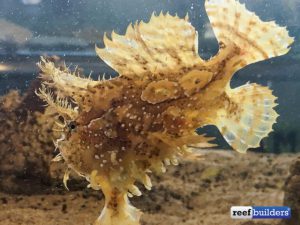
Sargassum washed ashore after a storm on Pensacola Beach. Photo credit: Carrie Stevenson, UF IFAS Extension
I am sure it drives the tourists a little crazy. After daydreaming all year of a week relaxing at the beach, they arrive and find the shores covered in leggy brown seaweed for long stretches. It floats in the shallow water, tickling legs and causing a mild panic—was that a fish? A jellyfish? A shark? Then, of course, high tide washes the seaweed up and strands it at the wrack line, shattering the vision of dreamy white sand beaches.
But for those visitors—and locals—willing to take a closer look, the brown algae known as sargassum is one of the most fascinating organisms in the sea. The next time you are at the beach, pick some up and turn it over in your hands. Sargassum is characterized by its bushy, highly branched stems with numerous leafy blades and berry-like, gas-filled structures. The tiny air sacs serve as flotation devices to keep the algae from sinking. This unique adaptation allows it to fulfill a niche at the top of the water column, instead of growing at the bottom or on another organism.

The sargassum fish blends incredibly well into its home within sargassum mats. It uses handlike pectoral fins to move around. Photo credit: Reef Builders
Sargassum tends to accumulate into large mats that drift through the water in response to wind and currents. These drifting mats create a pelagic habitat that attracts up to 70 species of marine animals. Several of these organisms are adapted specifically to life within the sargassum, reaching full growth at miniature sizes and camouflaged in shape, pattern, and color to blend in. These very specialized fauna include the sargassum crab, the sargassum shrimp, sargassum flatworm, sargassum nudibranch, sargassum anemone, and the sargassum fish! The sargassum fish (Histrio histrio) is in the toadfish family, a group of slow-moving reef fish that pick their way through coral and algae by using their pectoral fins like hands. Sea turtle hatchlings will spend their early years feeding and resting within the relative safety of large mid-ocean sargassum mats.

The small air-filled sacs of sargassum allow it to float on the surface, becoming the basis of a teeming ecosystem. Photo credit: Carrie Stevenson, UF IFAS Extension
Over time the air sacs lose buoyancy and the sargassum sinks, providing an important source of food for bottom-dwelling creatures. If washed ashore, many of the animals abandon the sargassum or risk drying out and dying.
In general, most of the larger, familiar seaweeds like sargassum are brown algae. Brown algae (including kelp and rockweed) have colors ranging from brown to brownish yellow-green. These darker colors result from the brown pigment fucoxanthin, which masks the green color of chlorophyll. Extractions from brown algae are commonly used in lotions and even heartburn medication!
- Hurricane Season 2025 - July 7, 2025
- The Striped Burrfish - April 11, 2025
- The Value of Biodiversity - March 28, 2025
